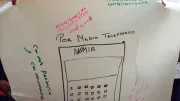Recent Blogs
Blog
How Did Bancolombia Create a Successful Rural Agent Network at Scale?
Bancolombia is a great example of a provider that's been successful in developing rural agent business models at scale, therefore playing a critical role in furthering financial inclusion. Here, we look at the factors that explain their success.Blog
Mobile Payments Take Shape in Latin America & the Caribbean
Mobile payments took hold over a decade ago, but Latin America didn't experience the traction seen elsewhere. Since then, two emerging business models for digital payments in Colombia and Haiti achieved particular success. What did they get right?Blog
Graduation Case Studies: An Opportunity to Learn & Scale Up
To further understand the opportunities and challenges faced by governments in the implementation of a Graduation Approach, the Ford Foundation has commissioned three case studies to examine the planning and execution of Graduation programs launched by the governments of Colombia, Peru and Ethiopia.Blog
The Replication Limits of M-Pesa in Latin America
Is the challenge of replicating the success of the M-Pesa model in Kenya more about implementation and management or about context and market structure? In Latin America and the Caribbean (LAC), the evidence points to context.Blog
Building a Toolbox for Bundling Services
In an increasingly competitive marketplace, could the bundling of credit with non-credit financial services be a viable solution for FSPs? EA Consultants designed and implemented a study with Crezcamos in Colombia to find out.Blog
Colombia’s Recipe for 100% Agent Coverage: Aggregation & Sharing
Universal coverage is a fundamental building block toward universal financial access. Last year Colombia announced that all of its 1,100+ municipalities had at least one banking agent serving customers in need of financial services. How did Colombia do it?Blog
Tech Relief for the High Cost of Field Research
Client-centered research can be expensive and logistically challenging. How can technology simplify this process?Blog
DaviPlata: Taking Mobile G2P Payments to Scale in Colombia
DaviPlata, a mobile wallet offered by Banco Davivienda in Colombia, is an application helping to shift social safety net payments – often paid in cash – to digital delivery.Blog
Papayas and Digital Finance: Emerging Consumer Risks in Colombia
The results from recently conducted design workshops with digital financial services clients in Colombia point to simple, yet innovative ideas to help mitigate consumer risks in digital finance.Blog
Buying Insurance – With Your Groceries – in Brazil, Colombia
Retail distribution of insurance comes with consumer protection challenges. Regulations in countries like Brazil aim to increase information offered to consumers, but supporting customers in navigating the process of buying and using insurance can still be difficult for sales staff.Blog
Who Should Pay for Banking Infrastructure in G2P Programs?
In 2006, 300 of Colombia's 1,100 municipalities had no access to banks. Now, 99% do. Incentives, while not enough to stimulate investment by private financial institutions in all remote areas, played a significant role in helping to build agent networks througout the country.Blog
You Can’t Go Cash-Lite on Empty Accounts: E-money vs. Cash
Getting people to reach for their bank card or mobile phone at the store check-out requires giving them good reasons to store their money electronically.Blog
How to Save Lives and Lower Fuel Consumption: Clean Cookstoves
Exposure to smoke from traditional cookstoves and open fires – the primary means of cooking and heating for nearly 3 billion people in the developing world – causes 2 million premature deaths annually, with women and children the most affected.Blog
Are Retailers Better Positioned to Offer Financial Services?
In our first post in this series on the role of consumer goods retailers in financial inclusion, we discussed how retailers are similar to MNOs in their ability to reach unbanked customers. However, the opportunity for financial inclusion via organized retail, while significant, is not present in every country and not necessarily for every type of retailer.Blog
A Bold Move Toward Simplifying AML/CFT: Lessons from Mexico
Regulators around the world today are beginning to realize that the chances of expanding access through branchless banking can be very limited without reducing the account-opening requirements through agents and mobile phones. The challenge is to strike the right balance between reducing account-opening requirements while maintaining basic controls for AML/CFT.Blog
Familias en Acción: A Financial Inclusion Strategy
In this post, our guest bloggers discuss the Government of Colombia’s efforts to use Conditional Cash Transfer (CCT) programs as a gateway to financial inclusion.Blog
Branchless Banking, G2P and Large Volume Payments
As branchless banking services reach the scale needed to be able to serve large segments of the population of a country, they are starting to strike partnerships with governments, businesses and not-for-profit organizations that need to make payments to large numbers of people.Blog
Which Way? Mobile Money and Branchless Banking in 2011
There was much movement in 2010 at the intersect of technology and access to finance for the poor. CGAP’s new Branchless Banking Database synthesizes a mass of data into a short 12-image “story” about what branchless banking is and the key hurdles we face in 2011. The focus is on mobile phones, but we quickly add that some of the most interesting work is still being done with debit cards and even simpler technologies, such as bar codes.Blog
Social Protection and Financial Inclusion
The 2010 Global Expert Colloquium on Savings and CCTs was co-sponsored by the Ford Foundation, Citi, UNDP, New America Foundation and Proyecto Capital.Blog












